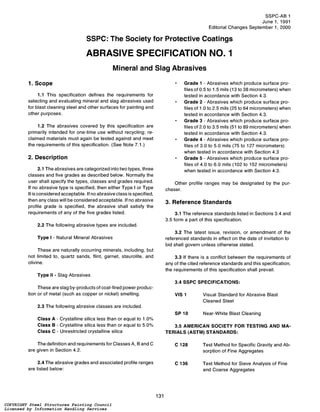This document outlines specifications for mineral and slag abrasives used for blast cleaning surfaces prior to painting or other coating applications. It defines two types (natural mineral or slag), three classes based on crystalline silica content, and five grades based on the surface profile produced. The specifications include physical and chemical property requirements for abrasives, as well as procedures for qualification testing, conformance testing, sampling, and documentation. Requirements address abrasive composition, hardness, moisture content, water soluble contaminants, and surface profile produced under standardized testing conditions.




![Appendix A. Optional Test
To Determine Rates
of Surface Cleaning by Abrasives and of Abra-
sive Consumption*
A.l TEST PROCEDURE
A.l.l For testing purposes hot rolled carbon steel
plates or other flat structural steel with surface area of 20 to
80 sq. ft. (1.9 to 7.4 m2)shall be abrasive blast cleaned to
a SSPC-SP 10“Near White”condition. Surface profile shall
range from 2.0 to 3.0 mils (51 to 76 micrometers) when
measured by replica tape (ASTM D-4417, Method C).
These panels shall be coated within 4 hours of abrasive
blasting, or before surface rusting is visible -whichever
occurs first.
A.1.2The panels prepared inA.l.l shall becoatedwith
three coats of epoxy-polyamide paint (total DFT 7-10 mils
[178-254 micrometers]) conforming to MIL-DTL-24441 or
other standard reference painting system agreed to by the
contracting parties. The panels shall be cured for a mini-
mum of seven days at a minimum temperature of 70°F (21’
C). Following curing. the panels shall be marked in such a
manner as to form a grid of squares, each being 1 sq. ft.
(0.09 m2)in area. Each plate shall contain a minimum of 20
squares.
SSPC-AB 1
June 1, 1991
Editorial Changes September 1, 2000
A.1.3 Each abrasive type and size selected shall be
tested using a 318 inch (9.6mm) venturi nozzle operated at
95 f5 psig (655f35 kilopascals) at the nozzle. A 600
Ibpot
shall be charges with 500 Ibs (227 kg) of abrasive and the
test panel blasted to SSPC-SP 10 near-white condition.
Each trial shall cover approximately 20 sq. ft. (2 m2) of
surface area. The blast pot shall be disconnected and
weighed before and after each blast trial, and the following
data recorded: start weight, finish weight, weight of abra-
sive used, square footage blasted, and time required to
blast.
A.2 ABRASIVE CONSUMPTION RATE: The abrasive
consumption rate shall be determined as the weight of
abrasive used divided by the area cleaned, and reported in
Ibs of abrasive per square foot (kg per m2).
A.3 SURFACE CLEANINGRATE: The surface clean-
ing rate shall be determined as the area cleaned divided by
the time required to blast and reported in square feet
(square meters) cleaned per hour.
*The Appendix is not a requirement of this specifica-
tion.
135
COPYRIGHT Steel Structures Painting Council
Licensed by Information Handling Services
COPYRIGHT Steel Structures Painting Council
Licensed by Information Handling Services](https://image.slidesharecdn.com/ab-1-221119224522-1e819788/85/ab-1-pdf-5-320.jpg)